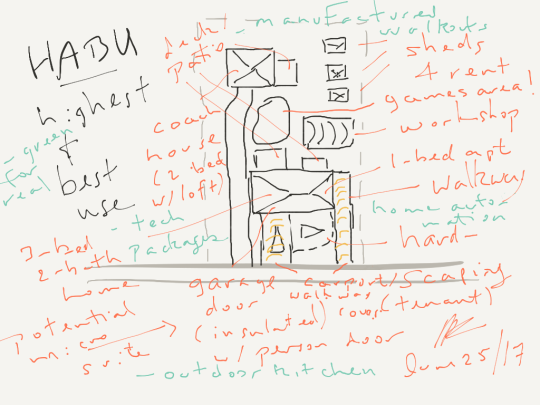
How to determine a site’s HABU, highest and best use?
For decades the principle of Highest and Best Use has guided town/city/township/county councils and their municipal planners and economic development offices.
To paraphrase Sir Winston Churchill, “It is the worst possible system except for all the others.”
It can be defined this way—
“Highest and best use for a property is achieved when the value created by its development for a specific set of physically possible, permitted uses (its functional program) and a particular form of structure combine to produce the highest present value of rents over the economic life of a project,” Bruce M Firestone
Today, we might modify this to include optimizing built form and its uses (function) to produce highest returns not only for owners/investors/developers but also its residents, tenants, visitors, guests, users, passersby, neighborhood, community and public room as well as city/town/state plus to give regard to durability in terms of food and energy production as well as environmental, ecological and social sustainability…
Anyway, here’s what we do to determine what uses a site might be best put to. You need to do:
a) site visit
b) review of zoning and official plan to understand what’s possible or probable
b) pre-consultation with city, neighbors, community groups, BIA and other stakeholders
c) streetscape and neighborhood analysis
d) if it’s not a vacant site, determine if existing building(s) should be kept/renovated/animated/added to…
e) figure out what the target market is or will be in the future, and see what animations (revenue improvements/enhancements) can be applied to the site or existing structures to make sure it is both economically and environmentally sustainable
f) concept plan or sketch plan
g) viable financing, leasing/rental and revenue/expense plan
“Nothing is sustainable unless it’s also economically sustainable,” Bruce M Firestone, PhD
h) spreadsheet analysis to support different land uses/options by examining the cap rate (capitalization rate) and IRR (internal rate of return) going-in (ie, for the property as it currently exists) and then also after you have animated/renovated/developed it and instituted proper leases (an often overlooked expertise) as well as property management
i) make recommendations and gain stakeholder/community/political acceptance
j) finally, for land purchase and development, make sure you can find a way to de-risk the project: Land development is usually such a lengthy, costly, risky process, that this is crucial–perhaps you can sever off and pre-sell some of the land at a higher price per acre or sq ft than your purchase price or bring in a co-developer to foot some of the heavy front end costs for acquisition, studies and approvals using a non-partnership, partnership model?
Prof Bruce
POSTSCRIPT: BY NON-PARTNERSHIP, PARTNERSHIP MODEL, I am talking about an arrangement, for example, where a co-developer shoulders some (or all) of the significant upfront costs in return for acquiring sole ownership of a chunk of the lands being acquired. The good news here is the entrepreneur who is project lead might end up owning the balance of the lands at a lower cost or possibly even free (or at a negative cost).
FOR REAL ESTATE INVESTMENT AND BUSINESS COACHING THAT’LL HELP YOU PROVIDE FOR YOURSELF AND YOUR FAMILY FOR 3-GENERATIONS, PLEASE CONTACT:
Bruce M Firestone, B Eng (civil), M Eng-Sci, PhD
Real Estate Investment and Business coach
ROYAL LePAGE Performance Realty broker
Ottawa Senators founder
1-613-762-8884
bruce.firestone@century21.ca
twitter.com/ProfBruce
profbruce.tumblr.com/archive
brucemfirestone.com
• MAKING IMPOSSIBLE POSSIBLE
• FREEDOM VIA REAL ESTATE INVESTMENT AND PB4L, PERSONAL BUSINESS FOR LIFE
• FEHAJ, FOR EVERY HOME A JOB
• MAKE YOUR HOME WORK FOR YOU, INSTEAD OF YOU WORKING FOR IT
• HIGHER ROI NOT JUST FOR OWNERS AND INVESTORS, BUT FOR TENANTS, GUESTS, VISITORS, NEIGHBORHOODS, COMMUNITIES, TOWNS, VILLAGES, CITIES AND THE ENVIRONMENT TOO
postscript: here’s my take on the HABU for a typical suburban lot that could and probably should be densified
(sorry it’s just a sketch)–

from Tumblr https://ift.tt/2ISY48f
Session expired
Please log in again. The login page will open in a new tab. After logging in you can close it and return to this page.